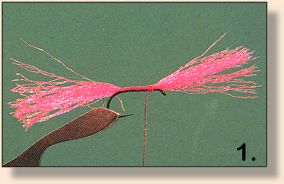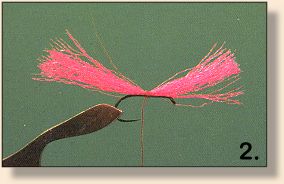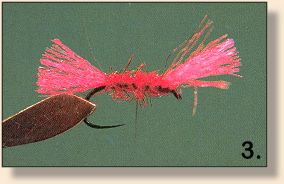This is a variation of a pattern designed some years
ago in England by David Shipman. It's ideal for
practicing tying small, and it's very simple, easy to
tie, and constructed for readily available materials.
It's also a versatile impressionistic pattern which
can be tied in a variety of sizes and colours.
Recipe: Micro-Shipman's Emerger
Hook: Straight eye dry, sizes 20 - 28.
Thread: 11/0 black or to match body.
Tail/Wing: A few fibres of white poly-yarn.
Body: Seal's fur, dubbed sparse and picked out,
various colours.
Tying Steps
Note: In the following illustrations, larger hooks
and brighter materials have been used for greater clarity.

1. Attach a length of poly-yarn in the middle of the hook
shank. Don't worry about the length of the yarn at this time,
as long as there is at least a hook length of fibre sticking
out both over the eye and back over the bend.

2. Wrap the poly-yarn down on top of the hood shank with
thread until it is secured from just behind the hook eye
until just forward of the bend.

3. Dub a few fibres of seal's fur onto the thread and
wrap a slim body. Keep it sparse. Tie off the thread
just behind the hook eye, but forward of the poly-yarn.
Pick out some of the fibres from each side of the body to
make a pair of wings and trim them for and aft to about
the body length. Lacquer the head and you're done.

Fishing Tips For the Small Stuff
(repeated from the original article).
Fish these patterns in the surface film, although you
can sink them to imitate nymphs. Fish take them for
midges and other tiny insects. Usually, colour and
size seem more important than shape/outline. Don't
forget to use the finest possible tippet and smallest
knots.

When presenting tiny patterns, do everything in slow
motion - including setting the hook. Indeed, just
gently tighten up your line and ease the hook into
the fish. Anything else will probably cause you to
quickly part company with your quarry. Some anglers
gently offset the hook point a little to improve the
hook-up percentage. Whatever you do, don't horse
the fish. Just gently apply pressure, especially
from the side, and ease it to the net. Make it do
its fighting in your net. Don't want to play it
too long, however, as you will exhaust the
fish - often fatally. Just use your common sense
to achieve a balance. ~ SS
We thank the
Canadian Fly Fisher for re-print permission!
| |





